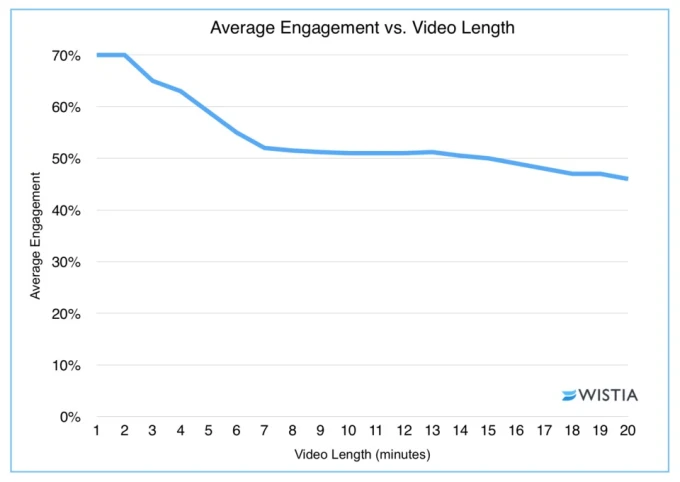Explainer videos are a great way to communicate with your audience and provide them with useful information. Video is by far the most effective method of content dissemination for marketing purposes.
Sujan Patel, the co-founder of Right Inbox, says, “Being able to see someone’s face, watch their expressions, and hear their tone of voice helps your customers connect with the speaker on an emotional level.”
But without a good script, your explainer video risks being dry, dull, or simply too long. You need to keep your audience engaged if you want to hold their attention. Read on, and I will show you how to write a great explainer video script in just seven steps.
Decide on the type of story you want to tell
We’ve all seen videos that go on for far longer than they need to. Others are unfocused, and bore the viewer or cause them to tune out. Your job as a video content producer is to tell a single, engaging story. To do this, you need to understand what story you want to tell.
Most explainer videos fall into one of two categories:
- Process overview. This type of video gives the viewer a clear picture of a process or demonstrates how a product or service works.
- Problem-solution. This is the usual way of promoting your product or service as something that can make the viewer’s life easier. It starts with a real-world problem, then uses the story to introduce your product as a solution to that problem.
If your story doesn’t fit neatly into either category, that’s not a problem. What’s important is that you give your viewers the value they’re looking for. You need to establish trust, then anticipate likely questions and answer them.
Before you get started, ask yourself these questions:
- What value is the viewer supposed to derive from this video?
- Why should they care?
- Why should they listen to you?
- What is the key takeaway from this video?
Your story should always be at the center of the explainer video. Get that right, and the rest will start falling into place.
Distill your story into its simplest form
Albert Einstein is often quoted as saying, “If you can’t explain something to a six-year-old, you don’t understand it yourself”. Whether or not he ever actually said this, it does impart an essential piece of storytelling wisdom: simplicity is best.
Therefore, the story you tell in your explainer video needs to be easy to understand. Use short sentences, avoid jargon or overly technical language, and be as concise as possible.
Put your viewer in the middle of the story
Unless your viewer can relate to the story you tell in your video, it won’t be effective. Ensuring it is relevant and relatable will help you to hold your audience’s attention.
Instead of merely listing features, tell a story that allows the viewer to picture themselves using your product to solve a problem. Use the second-person voice (“you”) to guide them through the process. In other words, ensure the viewer is the main character in the story.
There are many tools you can use to bring the story to life, such as 3-D animation, data visualization, and motion graphics. The human brain processes visual cues 60,000 times faster than text. Therefore, rely heavily on visual content and use text sparingly. In other words: Show, don’t tell.
Appeal to your viewer’s emotion
No good story ever started with a list of technical specifications. You will lose your audience quickly if your video does not make them feel anything.
Creating an emotional response means your viewers will be more invested in the outcome. In other words, they’ll keep watching to the end of your video, and may even click that “learn more” button. Harness the power of emotion by writing a story and script that taps into specific feelings.
With the right words, you can invoke excitement, fear, happiness, sadness, surprise, and a myriad of other feelings. Consider this example, which invokes shock and even disgust by telling us about immense amounts of food waste, then inspires hope by suggesting a solution:
Your choice of language, tone, music, motion graphics, and other storytelling devices should be appropriate to the emotion you’re trying to evoke. If in doubt, try things out and run A/B tests with a control group of viewers to see which ideas invoke the desired emotions.
Don’t discount the power of emotion, even if your video is about a highly technical topic. There is still the potential to appeal to your viewer’s feelings and create an emotional impact.
Adjust the length of the script for maximum impact
Length is important. If your script is too short, you won’t get all the required information in, or it will seem rushed. Too long, and your viewers will get bored and switch off. Your script must be the right length and pace to keep your audience engaged.
Column Five Media suggests you keep each explainer video to two minutes or less. While it is impossible to come up with a specific length that will work for every context, this is a useful rule of thumb to abide by.
A study conducted by video company Wistia analyzed more than 560,000 videos. It found that videos up to two minutes long kept a 70% engagement rate, the same rate as videos less than 30 seconds long. Beyond the two-minute mark, engagement dropped rapidly:

Source: Wistia
Two-minute scripts work well for explainer videos, tutorials, short product demos, and new release announcements. Make the most of a short video by using visual content and music as well as words for maximum impact.
Write for speech, not the page
Professional writers swear by reading their work aloud. Why? Because something that looks great on the page can sound clunky when spoken.
Remember that somebody will be reading your script for the video. Avoid these two mistakes at all costs:
- Complicated words. Long words that are difficult to say can ruin your video’s flow by interrupting the speaker’s rhythm. If you can find a simpler or shorter word that communicates the same thing, always use it.
- “Unspeakable” lines. If your script doesn’t mimic the way people naturally speak, it won’t resonate with your audience. Many scripts use an “ask-answer” structure that people don’t usually use in everyday speech. When you read your script aloud, ask yourself if it sounds like something a person would say. If not, change it.
Writing words to be spoken and words to be read are very different skills. Therefore, always read your script aloud and adjust it accordingly.
Take your script out for a test run
You’ve written your script, and you think it’s perfect. The next step is to get feedback from other people. Read the script aloud to a colleague, or make a recording to send to them, and ask for their feedback.
Other people identify flaws in our work that we do not always see. That’s why editors exist! Getting a second opinion will help you identify flaws in your script. A fresh pair of ears can eliminate clumsy copy, dead air, complicated language, and inappropriate tone.
Getting feedback also helps ensure your video will evoke the right emotional response. If something isn’t working, throw it away or rework it.
To sum it all up…
Explainer videos are a fantastic marketing tool. They impart a lot of information quickly and use a combination of visual and auditory content to hold the viewer’s attention. According to a study by Campaign Monitor, 83% of respondents said that video content was increasing in importance.
But you can only enjoy the full potential of video content if you write a great script. Remember the critical elements of the perfect explainer video:
- Understand the story you’re telling.
- Distill your story down to its simplest form.
- Make the viewer the main character.
- Strive to create an emotional response.
- Keep it short – two minutes is ideal.
- Write a script to be spoken, not to be read.
- Get feedback and adjust accordingly.
Writing the perfect script can take a few tries before you get it right. The best way to get better at creating great explainer videos is to watch plenty of them. Check out the Youtube channels of some of your favorite brands for inspiration for your video content.
When you get it right, you will start seeing the results in the form of positive engagements, shares, new leads, and more conversions. A great explainer video is not just a how-to or sales pitch. It is an experience that tells a story, takes the viewer on a journey, and engages with emotion.
Good luck with creating your first video!
This article has been contributed by Owen Baker.


